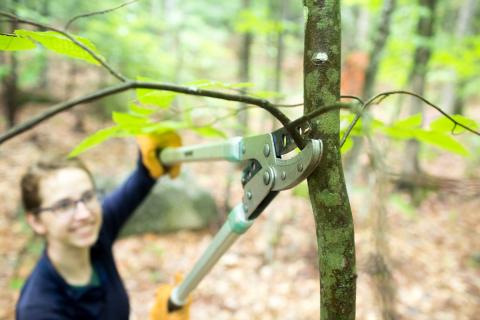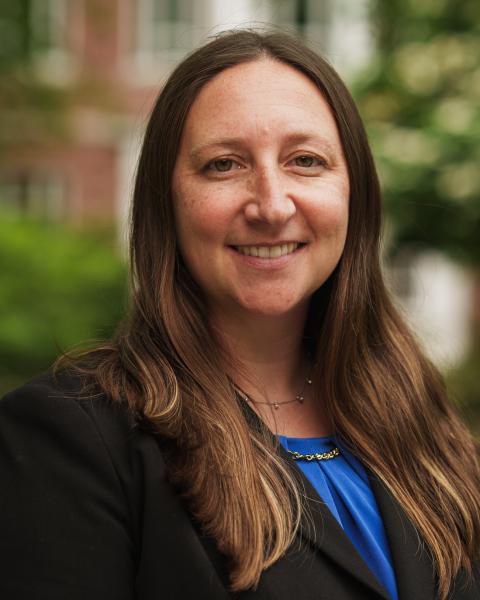UNH Extension Researchers Provide Guidance for Trail Stewardship in Coös County
Use of outdoor recreational trails has increased dramatically during the COVID-19 pandemic. Rails to Trails Conservancy found a 79% increase in trail use, and the Outdoor Industry Association reported an increase of 52.9% in outdoor recreation participation rates for U.S. residents in 2020 — the largest one-year jump on record.
New Hampshire has felt these impacts. Local land trusts and state and federal agencies work to broaden public engagement with trails, but the sudden, significant increase in outdoor recreation during the pandemic has led to challenges such as increased trash and human waste left on trails, as well as parking lot congestion.
To address concerns stemming from increased usage of trails in Coös County during the COVID-19 pandemic, the Neil and Louise Tillotson Fund of the NH Charitable Foundation awarded the University of New Hampshire Cooperative Extension a $31K grant to conduct research on trail stewardship.
A team of researchers at UNH Extension drew upon expertise from their Natural Resources, Community and Economic Development and Youth and Family program areas to conduct research from October 2021 through June 2022, which included interviews with professionals and volunteers from trails organizations as well as trail users.
The team sought to understand the key issues, constraints and challenges to the stewardship of human-powered recreational trails in Coös County. They also analyzed trail stewardship approaches and models at other organizations throughout the country to compile a set of tools and resources for trail stakeholders in this area.
UNH Extension Specialist for Community Volunteers and Manger of Nature Groupie Malin Clyde and UNH Extension Specialist for Community Engagement Molly Donovan led this research team.
Key Informant Interview Findings
The team utilized key informant interviews — a qualitative research method using one-on-one, discussion-based interviews with community representatives who are knowledgeable on the research subject (in this instance, trails). Key informants for this study were identified by the research team in collaboration with the Tillotson team. Informants included community stakeholders, land managers,
trails group members and municipality employees. Interviewees defined trail stewardship broadly to include volunteer management, fundraising, trail events and working with landowners and managers.
There were several findings; some include:
- Trail user safety was most widely cited as a priority; education of trail users (especially visitors and tourists) is needed to develop understanding of hiker responsibilities and norms for trail use and safety
- There is interest in mapping trails, tracking trail conditions and mapping stewardship responsibility for trails
- There is a strong culture of building and benefiting from partnerships with the organizations carrying out trail stewardship in Coös County
- The most common form of fundraising is securing grants; a link was not found between local businesses and financial support for trail stewardship
Key Informant Interview Recommendations
The research team made several recommendations to the county. Some include:
- Prioritizing stewardship attention on the busiest trails
- Exploring partnerships to help restore trails or fix problems on highly impacted areas
- Continuing to strengthen the network of local volunteers to build social capital in the community while widening volunteer recruitment by targeting local community members
- Inventorying local businesses that are benefiting from trails to determine if they would partner on events, fundraising or volunteer recruitment opportunities
- Promoting user safety through tactics such as high-quality mapping, reliable signage and wayfinding, user education and systems for reporting trail safety incidents
The team also conducted a small sample of trail intercept surveys, which indicated that local users are using these trails, but they are often confused about who manages local trails.
To improve trail stewardship, Extension’s team provided a toolbox with eight examples of collaborative organizations with successful structures and initiatives that can serve as models for Coös County.
Research Team
Malin Clyde and Molly Donovan were joined by four other Extension employees: Stewardship Outreach Program Manager Charlotte Thompson, Land and Water Conservation Field Specialist Emma Tutein, Wildlife Outreach Program Manager Haley Andreozzi and Healthy Living Field Specialist for Coös County Amanda Royce.
About The Neil and Louise Tillotson Fund
The vision of the Neil and Louise Tillotson Fund is to serve as a resource for the people of Coös County and neighboring communities in New Hampshire, Maine, Vermont and southern Québec to forge their own pathways to well-being and cultivate a region that thrives.
The Neil and Louise Tillotson Fund Community Investment Framework focuses investments in four key areas: Individual and Family Well-being, Healthy Workforce Ecosystem, Environmental Stewardship and Resilient Communities. Each year, the fund awards more than $3.5 million in grants to support economic development, education and community safety net programs. https://www.nhcf.org/what-were-up-to/focus-on/neil-and-louise-tillotson…
About UNH Cooperative Extension
UNH Cooperative Extension connects New Hampshire’s people and communities to trusted, research-based knowledge and information from the state’s flagship public university. For over 100 years, we have been drawing on our deep understanding of the state’s needs to support the economy, improve lives and make natural resources healthier and more productive. Learn more: https://extension.unh.edu/



